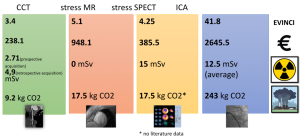In this study, we prospectively enrolled patients referred to our Radiology Institute, Department of Medicine DIMED – Padua University Hospital, to perform a CCT before surgery between December 2021 and February 2024. The subjects underwent an ECG-gated 128-slices GE revolution CCT examination. Acquisition was performed after bradycardization with e.v. metoprolol and sublingual isosorbide dinitrate administration. Calcium score (CA) was acquired in all patients.
Exclusion criteria were (1) high coronary calcium score (> 2065 for men and > 1377 for women), which compromises accuracy in the assessment of coronary stenosis; (2) elevated mean ventricular rate despite possible administration of beta blockers; (3) previous coronary artery bypass graft (CABG) surgery. A prospective (if HR <65 bpm and regular rythm) or retrospective (if HR <65 bpm and irregular rhythm or HR >65 bpm) ECG gating acquisition mode was used before and after the intravenous administration of Iomeron 400 contrast medium (flow rate 4.5 ml/s).
We assessed the difference between the relative and absolute costs, radiation exposure and CO2 emissions of the adopted non-invasive strategy (CCT followed by stress imaging and/or ICA when indicated) versus the invasive strategy traditionally used (ICA as first-line diagnostic tool). To quantify the costs associated to CCT, cardiac magnetic resonance (CMR) stress, single photon emission computed tomography (SPECT) stress, and ICA, we reported the absolute costs of the Veneto Region, traditionally considered a bench marketing Region in the Italian health management and the relative cost based on the rates reported in the Evaluation of Integrated Cardiac Imaging in Ischemic Heart Disease (EVINCI) study [4]. We extracted from the literature data the radiation doses in milliSieverts (mSv) associated to the cardiac imaging procedures [5], as well the CO2 emission values associated with the cardiac imaging exams performed [6,7], measured in carbon dioxide (CO2) emission equivalents and expressed in kilograms (kg) per procedure. [Figure 2]

Statistical analysis was performed using the Wilcoxon-Mann-Whitney Test.